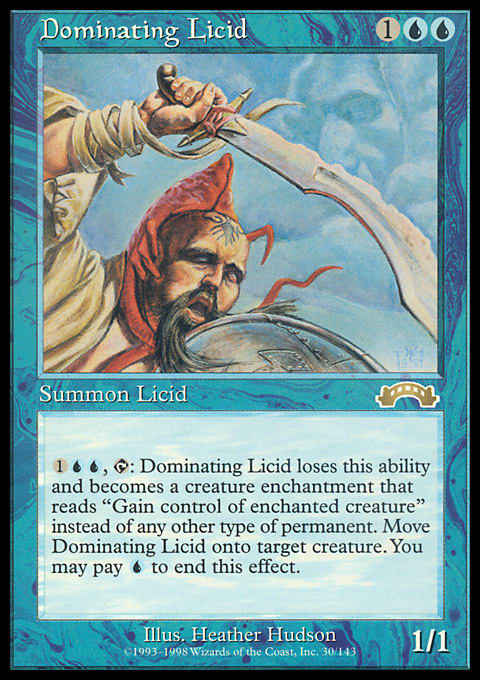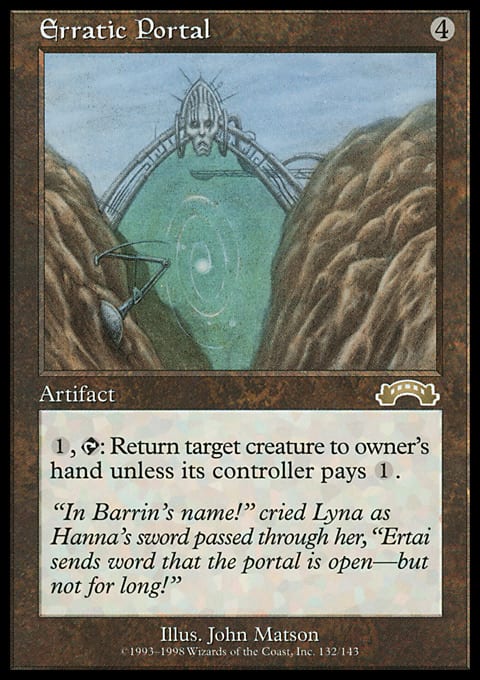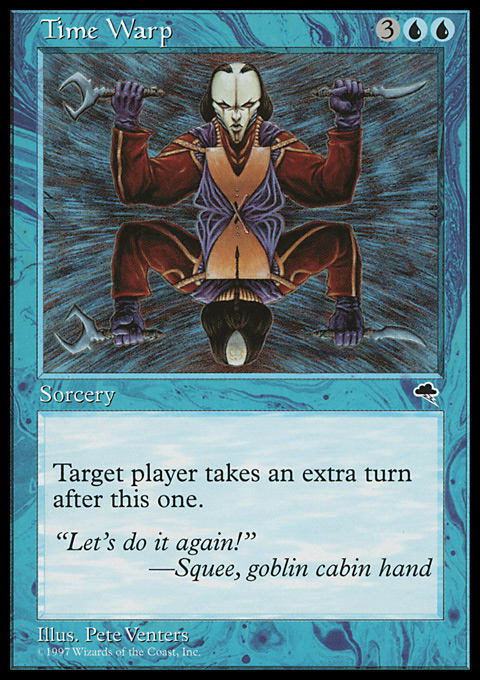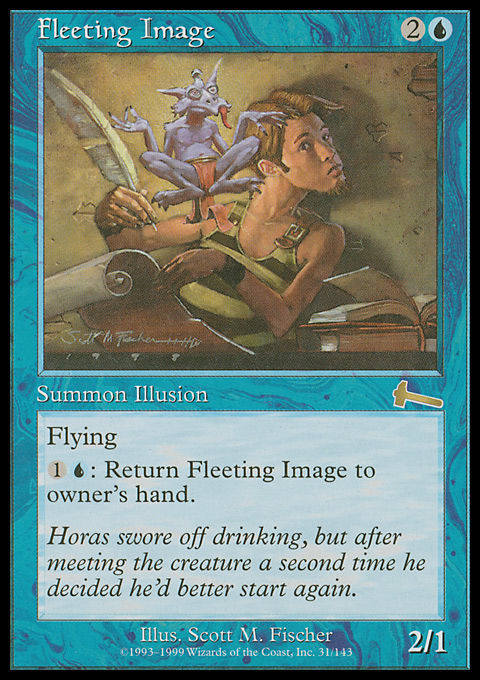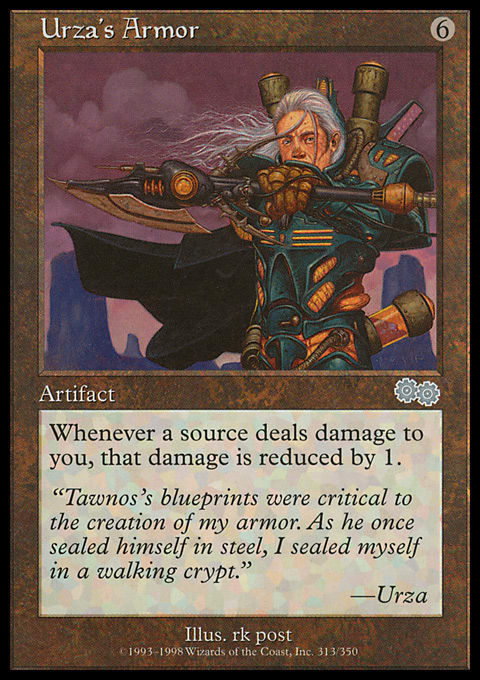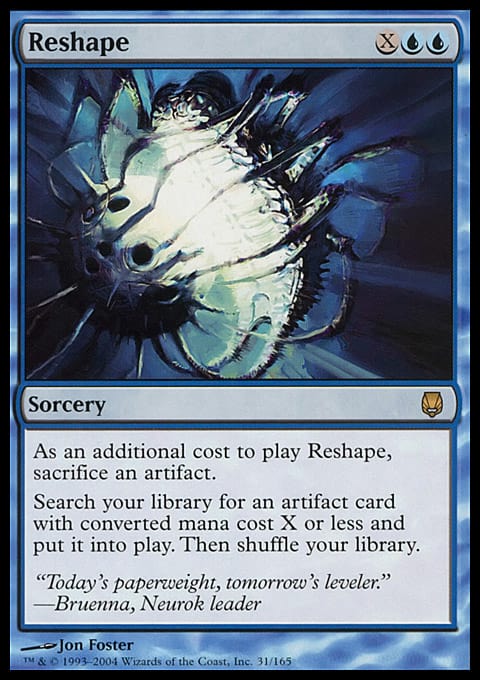With Aether Revolt fading in our rearview mirror, and signs beginning to show the mileage ahead to Amonkhet, I thought I’d like to delve a little more into the fascinating Preconstructed history of Magic: the Gathering. We’ve spent some time previously looking at two-color decks, but there does exist a mono-chromatic thread woven in amongst the tapestry.
It’s certainly less pronounced. The most common Theme Deck pairings are U/W and R/G, which each have fourteen different Theme Decks highlighting the intersection of those two colors. Nevertheless, from time to time Wizards has thrown a single-colored deck into the mix, and today we begin charting the course of Blue.
Blue was actually just the second color to ever get a full Theme Deck, which were introduced in 1997’s Tempest. The very next set, Stronghold, saw the Mono-Black Migraine, and a few months later is where our story begins.
Year: 1998
Set: Exodus
Deck: Dominator
Rares: Dominating Licid, Equilibrium, Erratic Portal
Dominator ? Theme Deck | Wizards of the Coast
- Creatures (13)
- 1 Dominating Licid
- 2 Cloud Spirit
- 2 Killer Whale
- 2 Mirozel
- 2 Wayward Soul
- 4 Thalakos Scout
- Instants (13)
- 2 Capsize
- 2 Forbid
- 2 Mind Games
- 3 Mana Leak
- 4 Counterspell
- Enchantments (4)
- 1 Equilibrium
- 1 Legacy's Allure
- 1 Propaganda
- 1 Treasure Trove
- Artifacts (1)
- 1 Erratic Portal
- Lands (26)
- 26 Island
If you wanted to set the standard for what Mono-Blue decks were about, you could do worse than to lead off with Dominator. There’s almost nothing straightforward about this tempo and control-style deck that pairs hard-to-remove creatures with a host of effects that can make your opponent’s mana base a pitfall.
First, the creatures. Although there are only thirteen of them, nearly all of them carry some form of evasion. Most, from the Cloud Spirit to the Mirozel and Wayward Souls, have out-and-out flying, alongside the Killer Whale which has the option to take to the air (and if you’re skeptical about a killer whale’s aerial attack ability, clearly you haven’t seen the classic 1997 film, Orca).
There’s also a playset of the Thalakos Scout here, whose shadow ability also can make them treacherous to deal with. And it’s not just blocking that can pose a challenge for an opponent — many are simply difficult to answer. The Wayward Soul can be bounced atop your library in response to a threat, while the Mirozel flees back to the relative safety of your hand whenever targeted. The Scouts, too, can be snatched back from the brink if you discard a card from hand. You may not be fielding innumerable threats, but the ones you do drop will tend to stick around.
To further protect your sources of damage, you have a playset of Counterspells, a trio of Mana Leaks, and two Forbids. Mind Games, Capsize, and Time Ebb all serve to make mayhem on your opponent’s side of the table, but some of the deck’s most tricky plays come with the mana taxing you’ll often be doing with the deck. In short, you’re going to make your opponent very cautious about tapping out.
We’ve already seen the Mana Leaks, which can force your opponent to play around them by holding mana open. But you also have the Erratic Portal, Fade Away, and Propaganda to keep their mana tied up. The more they have to spend to deal with your strategy, the less they’re playing their own.
The deck runs heavy on land itself, to take advantage of your buyback effects as well as a Treasure Trove. Throw in some creature theft through Legacy's Allure and the Dominating Licid, and you’ve got a deck that — when running well — can give your opponent some headaches.
Year: 1999
Set: Starter 1999
Deck: Time Curse
Time Curse ? Theme Deck | Wizards of the Coast
- Creatures (10)
- 2 Air Elemental
- 2 Giant Octopus
- 3 Ingenious Thief
- 3 Wind Drake
- Instants (7)
- 2 Counterspell
- 2 Extinguish
- 3 Remove Soul
- Sorceries (6)
- 1 Exhaustion
- 1 Ransack
- 1 Time Warp
- 1 Undo
- 2 Touch of Brilliance
- Lands (17)
- 17 Island
This 40-card deck was part of five Theme Decks released for the Starter 1999 introductory-level set. Each of the five were mono-colored, and for Blue, the set offered a fairly straightforward permission deck. This meant evasive creatures for closers, and spells to make sure they stuck around long enough to get the job done.
The evasive workhorses took the form of Wind Drakes and Air Elementals, with some Giant Octopuses in there to give you some defense against a ground-running opponent. Finally, three copies of Ingenious Thief added a little more to your aerial offense, while letting you see what your opponent was working with.
That was no idle benefit, either. The deck ran seven counters, two of them being the all-inclusive Counterspell while the others a little more narrow in focus (Remove Soul and Extinguish). The rest of the deck was a smattering of traditionally Blue effects, including card draw, library manipulation, and taking an extra turn.
It wasn’t the most exciting deck, but it was a solid introduction to what the color is all about. On that note, it was a success.
Year: 2001
Set: 7th Edition
Deck: Bomber
Rares: Ancestral Memories, Daring Apprentice
Bomber ? 7th Edition Precon | Wizards of the Coast
- Creatures (14)
- 1 Air Elemental
- 1 Coral Merfolk
- 1 Daring Apprentice
- 1 Fighting Drake
- 1 Glacial Wall
- 1 Horned Turtle
- 1 Merfolk Looter
- 1 Merfolk of the Pearl Trident
- 1 Prodigal Sorcerer
- 1 Sage Owl
- 1 Thieving Magpie
- 1 Wall of Air
- 2 Wind Drake
- Instants (7)
- 1 Force Spike
- 1 Inspiration
- 1 Unsummon
- 2 Boomerang
- 2 Counterspell
- Sorceries (2)
- 1 Ancestral Memories
- 1 Confiscate
- Lands (17)
- 17 Island
Like the previous entry, 7th Edition’s Preconstructed offerings were five, 40-card mono-colored decks. With the Core Sets now considered to be the fundamental building blocks of the game (the expansion sets as we know them were the “Advanced” or “Expert” releases), they laid a similarly fundamental foundation. This is Blue, Bomber promised, and this is what Blue does.
While that didn’t promise much in the way of complexity, the decks sought to make up for the fairly pedestrian themes by mixing it up with card diversity. There are only multiple copies of three key cards here (not counting basic lands, naturally) — everything else is a singleton copy. Much like Duel Decks, the intended effect is that each game will be wildly different than the last, increasing replayability.
Nevertheless, you could count on certain themes making themselves apparent over the course of play. For Bomber, that was (once again) aerial threats and permission spells. Wind Drake, Fighting Drake, and an Air Elemental all offered some aerial punch, with Thieving Magpie giving some card draw to go along with it. The red zone on the ground could be well-congested behind thickening agents like the Wall of Air, Glacial Wall, and Horned Turtle. Prodigal Sorcerer was the classic “pinger” that could pick off the weak and wounded, or keep up a steady trickle of damage to an opponent.
Backing this up was the usual and customary. Countermagic in the form of Counterspells and Force Spike. Disruption with Unsummon and two copies of Boomerang. Card draw with Inspiration and Ancestral Memories. Even a Confiscate, to make your opponent’s best permanent your own.
In short, a more robust version of Time Curse. We wouldn’t see another Mono-Blue deck until the following Core Set.
Year: 2003
Set: 8th Edition
Deck: Sky Slam
Rares: Fleeting Image, Urza's Armor
Sky Slam ? 8th Edition Precon | Wizards of the Coast
- Creatures (15)
- 1 Air Elemental
- 1 Aven Fisher
- 1 Coastal Hornclaw
- 1 Fighting Drake
- 1 Fleeting Image
- 1 Phantom Warrior
- 1 Puppeteer
- 1 Sage Owl
- 1 Spiketail Hatchling
- 2 Horned Turtle
- 2 Thieving Magpie
- 2 Wind Drake
- Instants (6)
- 1 Mana Leak
- 2 Remove Soul
- 3 Unsummon
- Enchantments (1)
- 1 Dehydration
- Artifacts (1)
- 1 Urza's Armor
- Lands (17)
- 17 Island
There isn’t a lot going on here that we haven’t seen before, but that’s not entirely unexpected. This isn’t an “expert-level” deck where you’d expect to see greater diversity and new mechanics/themes, but rather a Core Set deck that offers a baseline of color identity for those coming to the game.
That isn’t to say that Sky Slam doesn’t offer a few new tricks. To be sure, you’ve got all the elements of the core strategy here — evasive creatures and permission. But the 8th Edition had been designed to commemorate the 10th anniversary of the game, and this brought an injection of fresh cards to the Core Set environment. Wizards had run polls on the mothership letting players have a say as to what reprints were coming back, since it had been announced that every single Magic expansion would be offering up at least one new reprint to 8th Edition.
This helps explain the reappearance of Urza's Armor, originally an uncommon in Urza’s Saga that had never been brought back until now. Sure it cost 6 mana and could only offer substantive life savings against a swarm deck, but hey, Urza.
As for the creatures, nearly all of them are evasive, and those that aren’t tend to be designed to offer a hedge against ground attacks. Air Elemental, Thieving Magpie, Fighting Drake, Sage Owl, and Horned Turtle are all familiar faces, but we do get a new one in the Fleeting Image. This illusionary creature evokes the first deck we looked at, Dominator, in that it’s a creature that can be whisked away to safety when threatened.
For support, we have Mana Leak and Remove Soul serving as our counters. Counterspell, that archetype-defining staple since the start of the game, had been deemed too strong for the cost, and eased out to pasture. Weaker on counters, Sky Slam went in a more disruptive direction with a trio of Unsummons and a Dehydration to help answer opponent’s creature-based threats while it whittled away in the air.
The Core Set model would continue to endure well past 8th Edition, but, fortunately, Wizards delivered a more nontraditional Mono-Blue deck just seven months later.
Year: 2004
Set: Darksteel
Deck: Transference
Rares: Arcbound Reclaimer, Reshape
Transference ? Darksteel Precon | Wizards of the Coast
- Creatures (30)
- 1 Arcbound Fiend
- 1 Arcbound Lancer
- 1 Arcbound Reclaimer
- 1 Dross Scorpion
- 1 Juggernaut
- 1 Neurok Transmuter
- 1 Spincrusher
- 1 Spire Golem
- 1 Voltaic Construct
- 2 Arcbound Bruiser
- 2 Arcbound Crusher
- 2 Arcbound Hybrid
- 2 Arcbound Stinger
- 2 Cobalt Golem
- 2 Rust Elemental
- 2 Vedalken Engineer
- 3 Neurok Familiar
- 4 Arcbound Worker
- Instants (2)
- 2 Echoing Truth
- Sorceries (1)
- 1 Reshape
- Artifacts (4)
- 1 Dragon Blood
- 1 Ur-Golem's Eye
- 2 Skullclamp
- Lands (23)
- 21 Island
- 2 Seat of the Synod
Hurrah, an expansion set! Finally, we’ll get to see what Blue can do with a raft of new themes and mechanics, right? Well, not exactly . . . Only about a quarter of the deck is actually Blue. With Mirrodin having kicked off an artifacts-matter block, the majority of this deck comes from that card type. Instead, Blue is largely relegated to a supporting role.
The main thrust of the deck is the modular mechanic, as featured on the Arcbound creatures. These creatures are all 0/0’s that come into play instead with a varying number of +1/+1 counters on them. The catch is, when they die, you can put those counters on another creature. Little is wasted when you’ve got a field of Arcbound artifacts creatures, with each loss through attrition still serving to strengthen the rest of your army.
The most infamous of these would be the Arcbound Ravager, a win condition for broken Affinity decks that put a serious hurt on Magic’s competitive environment around this time. While the Ravager is absent, you have a host of others from the lowly Arcbound Worker to the mighty Arcbound Lancer.
These are particularly effective in a deck that runs harder-to-block options like Spincrusher, Spire Golem, and Rust Elemental. The latter in particular can put games on a very swift clock, as you sacrifice Arcbound creatures each upkeep and keep piling +1/+1 counters onto the ever-growing Elemental.
As for Blue, it offers some potential value plays in the Neurok Familiar, mana ramping in the Vedalken Engineer, and insurance against anti-artifact effects (like Shatter) with the Neurok Transmuter. You also get a pair of Echoing Truths, and a Reshape.
Although the deck ultimately doesn’t feel especially Blue, Transference illustrates just how large a tent Magic: the Gathering’s color pie can be. Believe me, if all we ever had to look forward to was the Bomber/Sky Slam template, the game would be far the worse off for it.
We’ll take a pause here and return in a week, when we look at the remaining history of Mono-Blue Theme Decks, Intro Packs and — yes — even an Event Deck!














